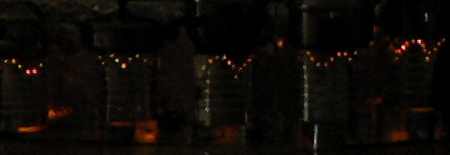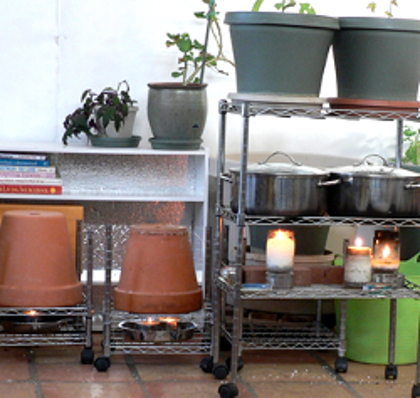
1/23/2018 ~ I have 2 candles going in my living room. It’s 39* outside, and 56* in my living room. Having 2 inch rigid insulation applied to my ceiling made a 10* difference in the heat retention in here. Happiness.
Tonight it’s supposed to get down to 15*, to in a bit I’ll add another two candles, making it 4 all together.
12/17/2015 ~ People who visit me for the first time almost invariably ask, “Can’t you get a wood stove?”
I reply, “95% of the heat from a wood stove goes up the chimney. With candles, 100% stays in my rooms. I just have to have enough plants to freshen the air.” I smile, and generally I can see that they are starting to think about it.
There’s also the wood vs wax issue. When I was young I chopped a lot of wood, and gathered wood from forests. Wax is much easier to deal with. Much. I have it delivered to my door, or more accurately, just inside my door, where the whole winter’s worth stacks easily in my hallway.
Pillar Candles
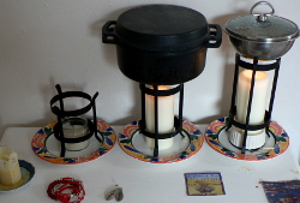
When I saw that I could cook with candles, I thought I could heat with them, but heating my bedroom using pillar candles wasn’t a success. Possibly I expected too much, or more likely, the caste iron pot in the picture wasn’t a good choice.
Nevertheless I went on using pillars, lamenting that I didn’t have enough things to raise pots above candles ~~ without a pot of water to hold the heat, heat dissipated quickly, whereas with a pot of hot water, the heat built up.
Nixing a wood stove
I wanted to get a wood burning stove, but didn’t have the money. In the end I’m glad ~~ Ordering wax and having it delivered is a lot easier than getting firewood. Plus, lighting a candle is easy, whereas lighting a wood fire has often been a challenge, especially when I’m cold and shivering.
The problem with pillar candles is that they create a pool of unburned wax that has dripped down into whatever catches it.
Many pillar candles seem to have been designed to burn the middle of the candle, but not the outside edges which appear to be made of a wax that melts at a higher temperature than the wax in the middle.
As the pillar burns, the outside walls remain, creating a hurricane lamp effect, that is, protecting the flame from air currents that would cause it to burn more rapidly.
5 day votive candles
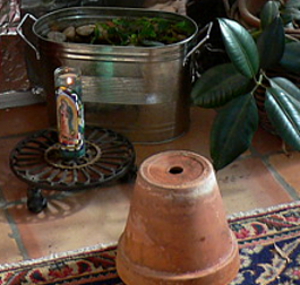
I began candle heating, in earnest, with a Guadalupe votive candle that stays lit for five days, a plant trolley to raise it off the floor so that more air could get to the flame, and a clay pot to put over the candle. The votive’s attraction was the glass jar, to hold the melted wax and protect the flame.
I put my mind to candle heating because I needed a way to keep my avocado warm (you can see in the photo how blackened its upper leaves were by the cold in my living room). For myself, I’d made a tent over my bed that was about as warm inside as my body temperature.
Yes, I have solar, and I love it. But my panels are not extensive enough to use to heat. Heating takes a lot of watts.
Why not go back to public utilities? Ha! Because I have been much healthier w/o their threats. They shut off my heat and lights, and WOW am I grateful !!!
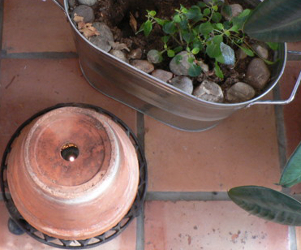
Staying lit… despite the clay pot it seems able to draw enough air through the trolley grate to support combustion.
Happiness!
But, will it be able to do that once I cover the top with a pot of water to retain the heat?

Nope. The smoke of extinction rose almost immediately ~~ dainty tendrils of smoke, but smoke none the less. And in this case, where the smoke was, there wasn’t fire.
Now, I must find three things of the same height to raise the clay pot so additional air can get in.
An ongoing challenge with candle heating is finding things of incremental height to raise candles as they burn down ~~ the closer the flame is to the pot of water, the more heat is captured.
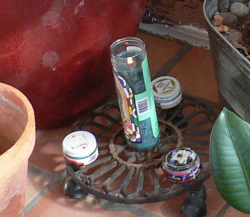
Happily, a box of shoe care items produced three jars of shoe polish, all the same height, and about the right height, at that.
But, would they work? Would an air inlet under the rim of the pot really make that much difference when the whole of the grate-like trolley had been an inlet?
I sure hoped so!
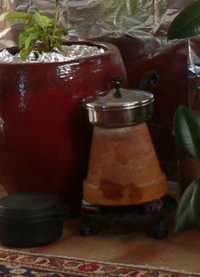
YES !!! My avocado has a little heater by its side.
Of all the pots and pans I’ve tried, the deep chef’s pan from Farberware with its aluminum core base heated up the best.
From having had baseboard hot water heat, as well as electric baseboard heat, I know that this is not the kind of heat that makes an immediate difference.
Radiant Heat vs Forced Air Heat
Radiant heat, the kind of heat I’m producing, is slow to make a difference because it heats things which then hold the heat and radiate it. The upside is that radiant heat is long lasting and even.
Forced air heating, on the other hand, heats the air and makes a rapid difference to the feeling of warmth in a room. But it turns off when it reaches the thermostatic setting, and equally quickly the room cools back down.
In order to keep rooms at the desired feeling of warmth the thermostat is turned higher with forced air, with the unintended side affect of more sinus drying air.
Radiant heat or baseboard heat takes quite awhile to change the warmth of a room but once it does, it doesn’t take very much energy to keep the room feeling relatively warm.
The feeling of warmth is important to understand. With forced air, we (that is, our bodies) are warmer than the things in a room, it is only the air that is warmer, not the things. So the things absorb the heat from us more quickly than from the air with the result that we feel cold.
In radiant heat, the source of the heat is a warm or hot object that radiates heat. The radiated heat primarily warms things. Things hold heat better than air does, so the heat lasts longer, and, it feels warmer.
Because the air isn’t heated and made particularly dry with radiant heating, it’s healthier for our sinuses.
Feeling the warmth
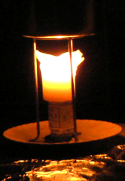
December 26, 2007 ~ Last night I started to get cold in my bedroom, inside my tent. I didn’t think much of it because it’s quite cold outside. But, when I went into the living room, the candle under the pot of water had gone out — the pot was cold. It took me twenty minutes to get a new candle in place: I had to find something to elevate it since the shoe polish jars I was using are now under the votive heating candles. An hour after I had it going again my room began to feel warmer. So, the candles make a lot of difference.
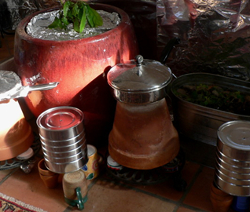
Knowing that candles worked to heat, I began using coffee cans to expand my candle heating system. Clay pots ran up costs, while coffee cans were in abundant supply due to my love of coffee.
Using wax bits
I began to wonder if I put a large pillars into a glass jar of some kind, if the candle would burn longer, like the tall votive candles. I expected it would. So I looked for a jar, but none of mine had a large enough mouth to allow me to put the pillar inside. Then, I remembered my apothecary jar, that I got to hold cotton balls and look cute. Sure enough, the candle fit in just fine, but the bottom of the jar stood up a bit in the middle, so the candle listed to one side. (And how lucky that was!)
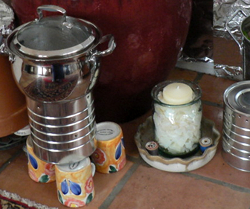
I collected the old bits and pieces of wax, breaking the bigger bits into smaller pieces, and placed them all around the candle till it stood up straight. Then I lit it and hoped for the best. That was on January 7.
Extended burn time
When it burned out, it had been going for six days, that’s twice as long as a three inch diameter, six inch tall pillar usually lasts. And all the wax bits were burned. It’s so great. Happiness. I don’t need to get wicks or a pot… I’m all set. I love it! What is that affirmation about, “I now have everything I need.”
Making candles
But buying a case of candles was a lot more expensive than buying wax and making candles in jars. Making candles that burn without a lot of soot, and create good heat is not as easy as you might imagine, so I’ll do a separate page showing what I’ve discovered works really well.
Improving Candle Heating
Coffee cans with holes punched to provide more air was a lovely time in my candle heating history. The dancing light that came through the punched holes was delightful. But, during the day there was no way to see what candles had gone out and needed replacing. So I had to endlessly lift coffee cans to check.
In this phase of candle heating, candles sat in plain sight on plant trolleys. They were easy to roll in and out when a candle needed replacing. However, there were no pots of water, so the heat wasn’t efficiently held.
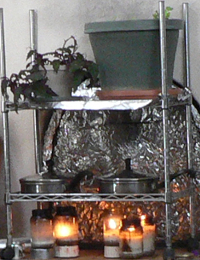
Today I use chrome carts to hold both my candles and the pots of water over my candles. The cart in the picture is sitting on the hearth to my useless fireplace (the firebox was built too close to the studs, so it’s a fire hazard unless I spend some major money on remediation).
For the carts sitting on the floor, I arrange the shelves so that they are a convenient height to change candles and refill pots with water.
As an aside, the candles on the right have a lot of paraffin wax, so the flame is burning strongly. On the left the candle flame has more of a glow because it hasn’t burned the wax completely and there’s a thin wall of soy wax diffusing the light. Soy wax burns more slowly and not as hot. Using soy keeps the paraffin from being too hot once the flame is within the jar. When the flame is too hot, it makes soot.
Similar articles, but different ~~
They shut off my heat and lights with no warning

